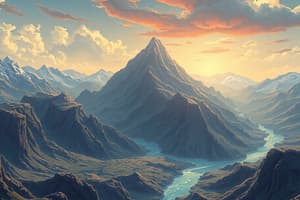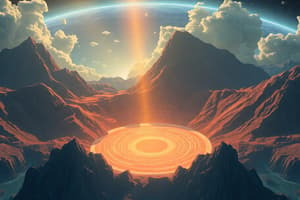Podcast
Questions and Answers
What causes tectonic earthquakes?
What causes tectonic earthquakes?
- Weathering of rocks
- Human activities
- Movement of tectonic plates (correct)
- Volcanic eruptions
Induced earthquakes are only caused by natural phenomena.
Induced earthquakes are only caused by natural phenomena.
False (B)
What are the three main types of rocks involved in the rock cycle?
What are the three main types of rocks involved in the rock cycle?
Igneous, sedimentary, metamorphic
The ______________ scale measures the intensity of an earthquake's effects.
The ______________ scale measures the intensity of an earthquake's effects.
Match the following types of plate boundaries with their descriptions:
Match the following types of plate boundaries with their descriptions:
Which of the following is NOT a division of the geological time scale?
Which of the following is NOT a division of the geological time scale?
Carbonates are primarily recognized for containing silicon and oxygen.
Carbonates are primarily recognized for containing silicon and oxygen.
Name one use of minerals in industry.
Name one use of minerals in industry.
The _______ era is known for the rise of mammals during the geological time scale.
The _______ era is known for the rise of mammals during the geological time scale.
Match the following geological events with their significance:
Match the following geological events with their significance:
Flashcards are hidden until you start studying
Study Notes
Earthquakes
- Definition: Sudden shaking of the ground caused by the movement of tectonic plates.
- Causes:
- Faults: Fractures in Earth's crust where rocks have moved.
- Volcanic activity: Eruptions can trigger earthquakes.
- Types:
- Tectonic earthquakes: Result from plate movements.
- Induced earthquakes: Caused by human activities (e.g., mining, reservoir-induced seismicity).
- Measurement:
- Magnitude: Scale measuring energy released (Richter scale, Moment Magnitude scale).
- Intensity: Effects of the earthquake on people and structures (Mercalli scale).
- Impact: Can cause destruction, tsunamis, and secondary hazards (landslides, liquefaction).
Plate Tectonics
- Theory: Explains the movement of Earth's lithosphere divided into tectonic plates.
- Types of plate boundaries:
- Divergent: Plates move apart (e.g., mid-ocean ridges).
- Convergent: Plates collide (e.g., subduction zones).
- Transform: Plates slide past each other (e.g., San Andreas Fault).
- Driving Forces:
- Mantle convection: Heat from Earth's interior causes movement.
- Slab pull and ridge push: Forces related to subduction and mid-ocean ridges.
- Consequences: Earthquakes, volcanic activity, mountain building, oceanic trench formation.
Rock Cycle
- Definition: Continuous process of rock formation, breakdown, and reformation.
- Types of rocks:
- Igneous: Formed from cooled magma (e.g., granite, basalt).
- Sedimentary: Formed from accumulation of sediments (e.g., limestone, sandstone).
- Metamorphic: Formed from existing rocks altered by heat/pressure (e.g., marble, schist).
- Processes:
- Weathering: Breaking down of rocks at Earth's surface.
- Erosion: Movement of weathered materials.
- Compaction/Cementation: Processes forming sedimentary rocks.
- Metamorphism: Transformation of rocks under heat and pressure.
- Cycle: Rocks can transition between types through processes over geological time.
Minerals
- Definition: Naturally occurring, inorganic solids with a definite chemical composition and crystal structure.
- Properties:
- Color: Visible hue.
- Luster: Appearance (metallic, non-metallic).
- Hardness: Resistance to scratching (Mohs scale).
- Streak: Color of the powdered form.
- Cleavage: Tendency to break along specific planes.
- Major types:
- Silicates: Contain silicon and oxygen (e.g., quartz, feldspar).
- Carbonates: Contain carbonate ions (e.g., calcite).
- Oxides: Contain metal and oxygen (e.g., hematite).
- Importance: Used in construction, electronics, jewelry, and as industrial resources.
Geological Time Scale
- Definition: Chronological dating system used to describe the timing and relationships of events in Earth's history.
- Divisions:
- Eons: Largest divisions (e.g., Hadean, Archean, Proterozoic, Phanerozoic).
- Eras: Subdivisions of eons (e.g., Paleozoic, Mesozoic, Cenozoic).
- Periods: Subdivisions of eras (e.g., Cambrian, Jurassic, Quaternary).
- Fossil Record: Used to date and understand the evolution of life and major changes in Earth's environment.
- Significance: Helps geologists understand the history of the Earth, including major geological and biological events.
Earthquakes
- Sudden ground shaking caused by tectonic plate movement.
- Faults are fractures in Earth's crust where rock movement occurs.
- Volcanic eruptions can also trigger earthquakes.
- Tectonic earthquakes are linked to plate movements, while induced earthquakes arise from human activities like mining.
- Magnitude measures energy released; measured on Richter and Moment Magnitude scales.
- Intensity assesses earthquake effects on people and structures; evaluated using the Mercalli scale.
- Earthquakes can result in destruction, tsunamis, and secondary hazards such as landslides and liquefaction.
Plate Tectonics
- Theory explaining the movement of Earth's lithosphere divided into tectonic plates.
- Divergent boundaries occur when plates move apart, exemplified by mid-ocean ridges.
- Convergent boundaries are where plates collide, such as in subduction zones.
- Transform boundaries involve plates sliding past each other, like the San Andreas Fault.
- Driving forces include mantle convection, slab pull, and ridge push.
- Resulting geological activities include earthquakes, volcanic eruptions, mountain formation, and oceanic trench creation.
Rock Cycle
- Continuous process involving rock formation, breakdown, and reformation.
- Igneous rocks form from cooled magma, with examples like granite and basalt.
- Sedimentary rocks result from the accumulation of sediments, with limestone and sandstone as key examples.
- Metamorphic rocks arise from existing rocks transformed by heat and pressure, like marble and schist.
- Weathering breaks down rocks at the surface, while erosion moves weathered materials.
- Compaction and cementation contribute to sedimentary rock formation.
- Metamorphism is the alteration of rocks due to heat and pressure.
- Rocks can transition between types through various processes across geological time.
Minerals
- Naturally occurring, inorganic solids with distinct chemical composition and crystal structure.
- Key properties include color, luster (metallic or non-metallic), hardness (measured on Mohs scale), streak, and cleavage.
- Major mineral types include silicates (containing silicon and oxygen, e.g., quartz), carbonates (containing carbonate ions, e.g., calcite), and oxides (containing metal and oxygen, e.g., hematite).
- Minerals play significant roles in construction, electronics, jewelry, and industrial resources.
Geological Time Scale
- Chronological dating system describing Earth's historical events and their timing.
- Eons represent the largest divisions of geological time, including Hadean, Archean, Proterozoic, and Phanerozoic.
- Eras are subdivisions of eons, including Paleozoic, Mesozoic, and Cenozoic.
- Periods are further subdivisions of eras, like Cambrian, Jurassic, and Quaternary.
- The fossil record is essential for dating, illustrating evolution and significant environmental changes.
- This scale aids geologists in understanding Earth’s history and major geological and biological events.
Studying That Suits You
Use AI to generate personalized quizzes and flashcards to suit your learning preferences.




